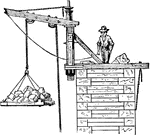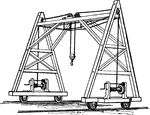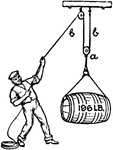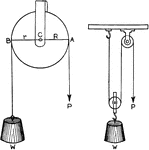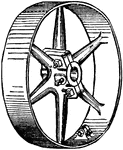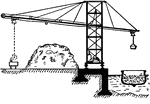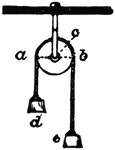The Pulleys ClipArt gallery offers 87 illustrations. Pulleys use ropes, cables, or belts along with grooved wheels to change the direction of an applied force or to increase mechanical force in a linear or rotational system.

Barrel and Fusee
"This is done in the mechanism of the watch, of which a, is the barrel containing the power in the form…

Block and Tackle
"A Block is a pulley or a system of pulleys rotating on a pintle mounted in its frame or shell with…

Block and tackle
"Combinations of pulleys are made in great variety. In the forms most commonly used, one continuous…

Block and tackle
"A combination of fixed and immovable pulleys, employed to secure what engineers call a large 'mechanical…
Compound Pulley
"If the number of ropes be increased, the weight may be increased with the same power; or the power…

Compound Pulley
"...there is a system of pulleys represented, in which the weight is sixteen times the power." -Comstock…
Compound Pulley
"Compound pulleys using one fixed and two moveable pulleys to pull a weight up by applying a downward…

Compound Pulley
"Compound pulley designed to use very little power to lift heavy weights." -Avery 1895

Construction Crane
Lifts and moves heavy objects; lifting tackle is suspended from a pivoted boom that rotates around a…

Fairbairn Steam Crane
The Fairbairn steam crane is a type of harbourside crane of an 'improved design', patented in 1850 by…

Fixed Hand Revolving Jib Crane
An illustration of a fixed hand revolving jib crane. A jib crane is a type of crane where a horizontal…
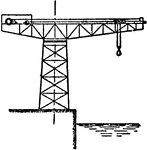
Hammerhead Crane
The "hammerhead", or giant cantilever, crane is a fixed-jib crane consisting of a steel-braced tower…
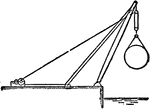
Jib Crane
A jib crane is a type of crane where a horizontal member (jib or boom), supporting a moveable hoist,…
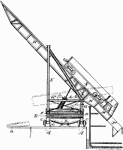
Crane for Lifting Cars
A crane is a lifting machine, generally equipped with a winder, wire ropes or chains and sheaves, that…
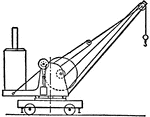
Portable Jib Crane
An illustration of a portable jib crane. A jib crane is a type of crane where a horizontal member (jib…
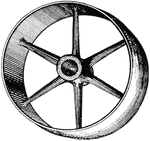
Crown Pulley
A pulley with a convex rim, much used where various cases belts are in danger of slipping off.

Derrick
An illustration of a derrick which is a lifting device made up of one pole which moves in all four directions…
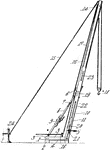
Industrial Derrick
Device that is used for lifting and moving large objects; A framework that is constructed over a mine…

Differential Pulley
"In the differential pulley, an endless chain is reeved upon a solid wheel that has two grooved rims…
!["A moveable pulley is seldom used alone. It is generally combined with a fixed pulley, as shown [here]." —Quackenbos 1859](https://etc.usf.edu/clipart/36300/36351/fixmove_pull_36351_mth.gif)
Fixed and Moveable Pulley
"A moveable pulley is seldom used alone. It is generally combined with a fixed pulley, as shown [here]."…
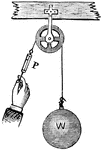
Fixed Pulley
"A pulley is a wheel having a grooved rim for carrying a rope or other line, and tuning on an axis carried…

Fixed Pulley
"A fixed pulley is one whose block is not movable. In this case, if the weight W be lifted by pulling…
!["[This illustration] represents a fixed pulley. The block is attached to a projecting beam. P is the power, and W the weight. For every inch that P descends, W ascends the same distance." —Quackenbos 1859](https://etc.usf.edu/clipart/36300/36349/fixed_pulley_36349_mth.gif)
Fixed Pulley
"[This illustration] represents a fixed pulley. The block is attached to a projecting beam. P is the…

Flat Rope Pulley
A pulley with a sheave having its perimeter a rectangular or nearly rectangular groove. Used for transmitting…

The Fusee
"A key is used to turn the cone, B. By doing so it wraps the chain around the cone and tightly coils…
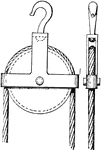
Gin-Block
"GIN-BLOCK. A simple form of tackle-block with a single wheel, over which a rope runs. It has a hook…

Hoisting and Conveying Apparatus
A hoist is a device used for lifting or lowering a load by mans of a drum or lift wheel around which…

Simple Machine
A fixed pulley. It is called such because the block is attached to the ceiling and cannot move.

Simple Machine
A moveable pulley. What differs between a moveable pulley and a fixed pulley is the fact that a moveable…

Movable pulley
"A pulley is a wheel having a grooved rim for carrying a rope or other line, and turning on an axis…

Movable Pulley
"A movable pulley is one whos block is movable. One end of the cord is fastened to the beam, and the…
!["[This illustration] represents a moveable pulley. A is the wheel. One end of the rope is fastened to a support at D, while the power is applied to the other at P." —Quackenbos 1859](https://etc.usf.edu/clipart/36300/36350/move_pulley_36350_mth.gif)
Moveable Pulley
"[This illustration] represents a moveable pulley. A is the wheel. One end of the rope is fastened to…

Movable Pulleys
"System of moveable pulleys. Each pulley has a separate rope attached to a fixed support at one end."…
Multiple Pulleys
"When a high degree of force is required, several moveable pulleys may be combined, as represented [here].…
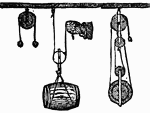
Pulley
A wheel for transmitting power from, or imparting it to the different parts of machinery, or for changing…
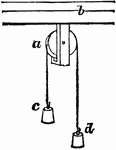
Pulley
"A pulley is a grooved wheel, around which a rope is passed, and is either fixed or moveable." —…
Pulley
"The pulley is a lever with equal arms of the first or second class, but, when it moves. the attachments…

Pulley
One of the six simple machines or mechanical powers. It consists of a grooved wheel mounted in a block,…
!["[The pulley] consists of a wheel with a grooved circumference, over which a rope passes, and an axis or pin, round which the wheel may be made to turn. A represents the block, B the axis, C the wheel." —Quackenbos 1859](https://etc.usf.edu/clipart/36300/36348/pulley_36348_mth.gif)
Pulley
"[The pulley] consists of a wheel with a grooved circumference, over which a rope passes, and an axis…
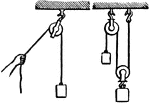
Pulley
"In the single fixed pulley (fig. 1) there is no mechanical advantage, the power and weight being equal.…

Pulley
"In a system of pulleys (figs. 3,4) in which the same string passes round any number of pulleys, and…

Pulley
"In a system in which each pulley hangs by a separate cord and the strings are parallel (fig. 5), there…

Pulley
A pulley (also called a block) is a mechanism composed of a wheel (called a sheave) with a groove between…
Pulley
A pulley (also called a block) is a mechanism composed of a wheel (called a sheave) with a groove between…
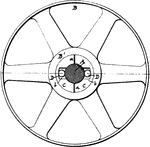
Pulley
A pulley, also called a sheave or a drum, is a mechanism composed of a wheel on an axle or shaft that…

Pulley Blocks
An illustration of a block pulley. A pulley (also called a block) is a mechanism composed of a wheel…
Pulley Blocks
An illustration of a block pulley. A pulley (also called a block) is a mechanism composed of a wheel…
Pulley Blocks
An illustration of a block pulley. A pulley (also called a block) is a mechanism composed of a wheel…
